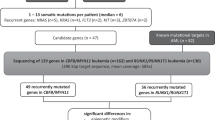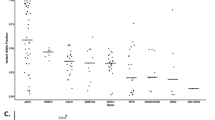Abstract
c-KIT mutations have been described in core-binding factor (CBF) acute myeloid leukemia (AML) at diagnosis. The role of c-KIT mutations in the relapse of CBF–AML is not clear. The role of CSF1R mutation in the pathogenesis of AML remains to be determined. We analyzed receptor tyrosine kinases (RTKs) and Ras mutations on 154 children with AML. Also, we examined the paired diagnosis and relapse samples in CBF–AML. CBF–AML accounted for 27% (41/154). c-KIT mutations were detected in 41.5% of CBF–AML at diagnosis (6 in exon 8, 10 in exon 17 and 1 in both exons 8 and 17) , FLT3–TKD 2.7%, N-Ras mutations 7.3% and K-Ras mutations 4.9%. FLT3–LM and CSF1R mutations were not found in CBF–AML. The mutations of RTKs and Ras were mutually exclusive except for one patient who had both c-KIT and N-Ras mutations. Eight of the 41 CBF–AML patients relapsed; four patients retained the identical c-KIT mutation patterns as those at diagnosis, the remaining four without c-KIT mutations at diagnosis did not acquire c-KIT mutations at relapse. Our study showed that 54% of childhood CBF–AML had RTKs and/or Ras mutations; c-KIT but not CSF1R mutations play a role in the leukemogenesis of childhood CBF–AML.
This is a preview of subscription content, access via your institution
Access options
Subscribe to this journal
Receive 12 print issues and online access
$259.00 per year
only $21.58 per issue
Buy this article
- Purchase on Springer Link
- Instant access to full article PDF
Prices may be subject to local taxes which are calculated during checkout
Similar content being viewed by others
References
Vardiman JW, Harris NL, Brunning RD . The World Health Organization (WHO) classification of the myeloid neoplasms. Blood 2002; 100: 2292–2302.
Kelly LM, Gilliland DG . Genetics of myeloid leukemias. Annu Rev Genomics Hum Genet 2002; 3: 179–198.
Reilly JT . Class III receptor tyrosine kinases: role in leukaemogenesis. Br J Haematol 2002; 116: 744–757.
Kondo M, Horibe K, Takahashi Y, Matsumoto K, Fukuda M, Inaba J et al. Prognostic value of internal tandem duplication of the FLT3 gene in childhood acute myelogenous leukemia. Med Pediatr Oncol 1999; 33: 525–529.
Iwai T, Yokota S, Nakao M, Okamoto T, Taniwaki M, Onodera N et al. Internal tandem duplication of the FLT3 gene and clinical evaluation in childhood acute myeloid leukemia. The Children's Cancer and Leukemia Study Group, Japan. Leukemia 1999; 13: 38–43.
Xu F, Taki T, Yang HW, Hanada R, Hongo T, Ohnishi H et al. Tandem duplication of the FLT3 gene is found in acute lymphoblastic leukaemia as well as acute myeloid leukaemia but not in myelodysplastic syndrome or juvenile chronic myelogenous leukaemia in children. Br J Haematol 199; 105: 155–162.
Meshinchi S, Woods WG, Stirewalt DL, Sweetser DA, Buckley JD, Tjoa TK et al. Prevalence and prognostic significance of Flt3 internal tandem duplication in pediatric acute myeloid leukemia. Blood 2001; 97: 89–94.
Liang DC, Shih LY, Hung IJ, Yang CP, Chen SH, Jaing TH et al. Clinical relevance of internal tandem duplication of the FLT3 gene in childhood acute myeloid leukemia. Cancer 2002; 94: 3292–3298.
Beghini A, Ripamonti CB, Cairoli R, Cazzaniga G, Colapietro P, Elice F et al. KIT activating mutations: incidence in adult and pediatric acute myeloid leukemia, and identification of an internal tandem duplication. Haematologica 2004; 89: 920–925.
Goemans BF, Zwaan CM, Miller M, Zimmermann M, Harlow A, Meshinchi S et al. Mutations in KIT and RAS are frequent events in pediatric core-binding factor acute myeloid leukemia. Leukemia 2005; 19: 1536–1542.
Boissel N, Leroy H, Brethon B, Philippe N, de Botton S, Auvrignon A et al. Incidence and prognostic impact of c-KIT, FLT3, and Ras gene mutations in core binding factor acute myeloid leukemia (CBF-AML). Leukemia 2006; 20: 965–970.
Shimada A, Taki T, Tabuchi K, Tawa A, Horibe K, Tsuchida M et al. KIT mutations, and not FLT3 internal tandem duplication, are strongly associated with a poor prognosis in pediatric acute myeloid leukemia with t(8;21): a study of the Japanese Childhood AML Cooperative Study Group. Blood 2006; 107: 1806–1809.
Care RS, Valk PJ, Goodeve AC, Abu-Duhier FM, Geertsma-Kleinekoort WM, Wilson GA et al. Incidence and prognosis of c-KIT and FLT3 mutations in core binding factor (CBF) acute myeloid leukaemias. Br J Haematol 2003; 121: 775–777.
Cairoli R, Beghini A, Grillo G, Nadali G, Elice F, Ripamonti CB et al. Prognostic impact of c-KIT mutations in core binding factor leukemias: an Italian retrospective study. Blood 2006; 107: 3463–3468.
Paschka P, Marcucci G, Ruppert AS, Mrozek K, Chen H, Kittles RA et al. Adverse prognostic significance of KIT mutations in adult acute myeloid leukemia with inv(16) and t(8;21): a Cancer and Leukemia Group B Study. J Clin Oncol 2006; 24: 3904–3911.
Liang DC, Shih LY, Yang CP, Hung IJ, Chen SH, Liu HC . Molecular analysis of fusion transcripts in childhood acute myeloid leukemia in Taiwan. Med Pediatr Oncol 2001; 37: 555–556.
Bennett JM, Catovsky D, Daniel MT, Flandrin G, Galton DA, Gralnick HR et al. Criteria for the diagnosis of acute leukemia of megakaryocyte lineage (M7). A report of the French-American-British Cooperative Group. Ann Intern Med 1985; 103: 460–462.
Bennett JM, Catovsky D, Daniel MT, Flandrin G, Galton DA, Gralnick HR et al. Proposed revised criteria for the classification of acute myeloid leukemia. A report of the French-American-British Cooperative Group. Ann Intern Med 1985; 103: 620–625.
Keenan FM, Barnett D, Reilly JT . Clinico-pathological features of minimally differentiated acute myeloid leukaemia (AML-M0). Br J Haematol 1992; 81: 458–459.
Shih LY, Liang DC, Fu JF, Wu JH, Wang PN, Lin TL et al. Characterization of fusion partner genes in 114 patients with de novo acute myeloid leukemia and MLL rearrangement. Leukemia 2006; 20: 218–223.
Liang DC, Chan TT, Lin KH, Lin DT, Lu MY, Chen SH et al. Improved treatment results for childhood acute myeloid leukemia in Taiwan. Leukemia 2006; 20: 136–141.
Shih LY, Huang CF, Wu JH, Lin TL, Dunn P, Wang PN et al. Internal tandem duplication of FLT3 in relapsed acute myeloid leukemia: a comparative analysis of bone marrow samples from 108 adult patients at diagnosis and relapse. Blood 2002; 100: 2387–2392.
Spritz RA, Giebel LB, Holmes SA . Dominant negative and loss of function mutations of the c-KIT (mast/stem cell growth factor receptor) proto-oncogene in human piebaldism. Am J Hum Genet 1992; 50: 261–269.
Liang DC, Shih LY, Hung IJ, Yang CP, Chen SH, Jaing TH et al. FLT3-TKD mutation in childhood acute myeloid leukemia. Leukemia 2003; 17: 883–886.
Liang DC, Shih LY, Fu JF, Li HY, Wang HI, Hung IJ et al. K-Ras mutations and N-Ras mutations in childhood acute leukemias with or without mixed-lineage leukemia gene rearrangements. Cancer 2006; 106: 950–956.
Meshinchi S, Stirewalt DL, Alonzo TA, Zhang Q, Sweetser DA, Woods WG et al. Activating mutations of RTK/ras signal transduction pathway in pediatric acute myeloid leukemia. Blood 2003; 102: 1474–1479.
Kohl TM, Schnittger S, Ellwart JW, Hiddemann W, Spiekermann K . KIT exon 8 mutations associated with core-binding factor (CBF)-acute myeloid leukemia (AML) cause hyperactivation of the receptor in response to stem cell factor. Blood 2005; 105: 3319–3321.
Kitayama H, Tsujimura T, Matsumura I, Oritani K, Ikeda H, Ishikawa J et al. Neoplastic transformation of normal hematopoietic cells by constitutively activating mutations of c-KIT receptor tyrosine kinase. Blood 1996; 88: 995–1004.
Wang YY, Zhou GB, Yin T, Chen B, Shi JY, Liang WX et al. AML1-ETO and C-KIT mutation/overexpression in t(8;21) leukemia: implication in stepwise leukemogenesis and response to Gleevec. Proc Natl Acad Sci USA 2005; 102: 1104–1109.
Gilliland DG, Griffin JD . Role of FLT3 in leukemia. Curr Opin Hematol 2002; 9: 274–281.
Sherr CJ . Colony-stimulating factor-1 receptor. Blood 1990; 75: 1–12.
Tobal K, Pagliuca A, Bhatt B, Bailey N, Layton DM, Mufti GJ . Mutation of the human FMS gene (M-CSF receptor) in myelodysplastic syndromes and acute myeloid leukemia. Leukemia 1990; 4: 486–489.
Ridge SA, Worwood M, Oscier D, Jacobs A, Padua RA . FMS mutations in myelodysplastic, leukemic, and normal subjects. Proc Natl Acad Sci USA 1990; 87: 1377–1380.
Natazuka T, Matsui T, Ito M, Nakata H, Nakagawa T, Nakamura H et al. Rare point mutation at codon 301 and 969 of FMS/M-CSF receptor in acute myelomonocytic and monocytic leukemia. Leuk Res 1992; 16: 541–543.
Springall F, O'mara S, Shounan Y, Todd A, Ford D, Iland H . CSF1R point mutations in acute myeloid leukemia: fact or fiction? Leukemia 1993; 7: 978–985.
Abu-Duhier FM, Goodeve AC, Wilson GA, Peake IR, Reilly JT . CSF1R mutational analysis in acute myeloid leukaemia. Br J Haematol 2003; 123: 749–750.
Schnittger S, Kohl TM, Haferlach T, Kern W, Hiddemann W, Spiekermann K et al. KIT-D816 mutations in AML1-ETO-positive AML are associated with impaired event-free and overall survival. Blood 2006; 107: 1791–1799.
Acknowledgements
This work was supported by grants MMH-E-94009 and MMH-E-95009 from the Mackay Memorial Hospital, grant NSC 94-2314-B-195-003 from the National Science Council and grant NHRI-EX96-9434SI from the National Health Research Institute, Taiwan.
Author information
Authors and Affiliations
Corresponding author
Additional information
Supplementary Information accompanies the paper on the Leukemia website (http://www.nature.com/leu)
Supplementary information
Rights and permissions
About this article
Cite this article
Shih, LY., Liang, DC., Huang, CF. et al. Cooperating mutations of receptor tyrosine kinases and Ras genes in childhood core-binding factor acute myeloid leukemia and a comparative analysis on paired diagnosis and relapse samples. Leukemia 22, 303–307 (2008). https://doi.org/10.1038/sj.leu.2404995
Received:
Revised:
Accepted:
Published:
Issue Date:
DOI: https://doi.org/10.1038/sj.leu.2404995
Keywords
This article is cited by
-
Molecular dissection of a hyper-aggressive CBFB-MYH11/FLT3-ITD–positive acute myeloid leukemia
Journal of Translational Medicine (2022)
-
Targeting transcription factors in cancer — from undruggable to reality
Nature Reviews Cancer (2019)
-
Molecular and genetic alterations associated with therapy resistance and relapse of acute myeloid leukemia
Journal of Hematology & Oncology (2017)
-
Significance of KIT exon 17 mutation depends on mutant level rather than positivity in core-binding factor acute myeloid leukemia
Blood Cancer Journal (2016)
-
Adverse prognostic impact of KIT mutations in childhood CBF-AML: the results of the Japanese Pediatric Leukemia/Lymphoma Study Group AML-05 trial
Leukemia (2015)



